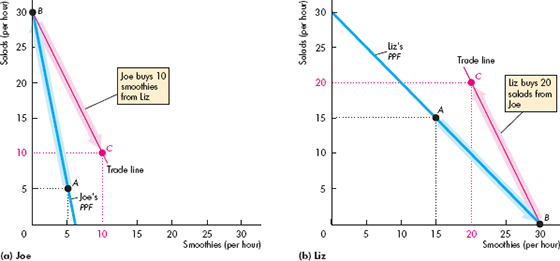
Macroeconomics 11th Edition by Michael Parkin
Edition 11ISBN: 9780133423884
Macroeconomics 11th Edition by Michael Parkin
Edition 11ISBN: 9780133423884 Exercise 32
Use the following data to work Problem. Brazil produces ethanol from sugar at a cost of 83 cents per gallon. The United States produces ethanol from corn at a cost of $1.14 per gallon. Sugar grown on one acre of land produces twice the quantity of ethanol as the corn grown on an acre. The United States imports 5 percent of the ethanol it uses and produces the rest itself. Since 2003, U.S. ethanol production has more than doubled and U.S. corn production has increased by 45 percent.
Sketch a figure similar to Fig. to show how both the United States and Brazil can gain from specialization and trade.
Figure
The Gains from Trade

Initially, Joe produces at point A on his PPF in part (a), and Liz produces at point A on her PPF in part (b). Joe's opportunity cost of producing a salad is less than Liz's, so Joe has a comparative advantage in producing salads. Liz's opportunity cost of producing a smoothie is less than Joe's, so Liz has a comparative advantage in producing smoothies.
If Joe specializes in making salads, he produces 30 salads and no smoothies at point B on his PPF. If Liz specializes in making smoothies, she produces 30 smoothies and no salads at point B on her PPF. They exchange salads for smoothies along the red "Trade line." Liz buys salads from Joe for less than her opportunity cost of producing them. Joe buys smoothies from Liz for less than his opportunity cost of producing them. Each goes to point C -a point outside his or her PPF. With specialization and trade, Joe and Liz gain 5 smoothies and 5 salads each with no extra resources.
Sketch a figure similar to Fig. to show how both the United States and Brazil can gain from specialization and trade.
Figure
The Gains from Trade

Initially, Joe produces at point A on his PPF in part (a), and Liz produces at point A on her PPF in part (b). Joe's opportunity cost of producing a salad is less than Liz's, so Joe has a comparative advantage in producing salads. Liz's opportunity cost of producing a smoothie is less than Joe's, so Liz has a comparative advantage in producing smoothies.
If Joe specializes in making salads, he produces 30 salads and no smoothies at point B on his PPF. If Liz specializes in making smoothies, she produces 30 smoothies and no salads at point B on her PPF. They exchange salads for smoothies along the red "Trade line." Liz buys salads from Joe for less than her opportunity cost of producing them. Joe buys smoothies from Liz for less than his opportunity cost of producing them. Each goes to point C -a point outside his or her PPF. With specialization and trade, Joe and Liz gain 5 smoothies and 5 salads each with no extra resources.
Explanation
Given,
Brazil produces Ethanol from suga...
Macroeconomics 11th Edition by Michael Parkin
Why don’t you like this exercise?
Other Minimum 8 character and maximum 255 character
Character 255



